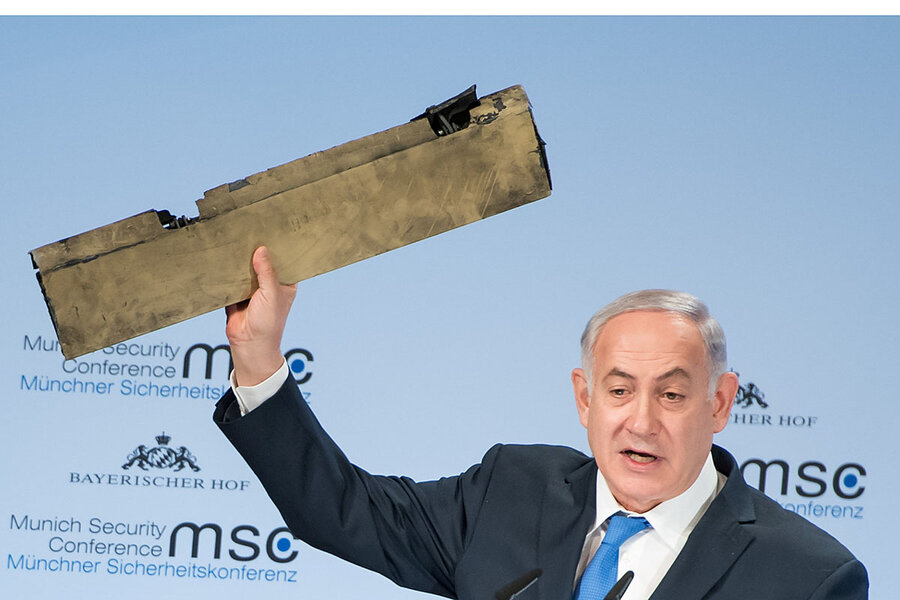Israel and Iran: A long-running rivalry moves to center stage
Loading...
| London
It was, as intended, a moment of high drama at last weekend’s international security conference in Munich. Holding up a fragment from an Iranian military drone shot down by his air force, Israeli Prime Minister Benjamin Netanyahu looked out at Iran’s foreign minister and warned: “Do not test Israel’s resolve.”
The conflict between these rival powers is not new – with roots going back to the 1979 Islamic revolution that toppled the Shah of Iran, a key United States ally and the only Middle East leader at the time with close ties to the Israelis. But it is taking on new importance, with new potential perils, as a result of the war across Israel’s border in Syria, and the web of international tensions now surrounding that country’s future.
Perhaps the most surprising thing about the military clash that followed the drone incident of a week ago was that it took so long to happen.
The real turning point in Iranian-Israeli tension came three years after the Islamic revolution, with Israel’s 1982 invasion of Lebanon. Israel’s aim was to expel armed Palestinian groups from across the border. Yet once Yasser Arafat and the Palestine Liberation Organization were pushed out, a new – and, over time, more powerfully armed – adversary took their place: the Shiite Muslim militia Hezbollah, not just inspired but armed and financed by Iran and by the Iranians’ closest Arab ally, Syria.
Since the outbreak of the war in Syria, the situation has been getting inexorably more fraught. As the regime of President Bashar al-Assad moved to crush its opponents, the outside world’s focus has rightly been on the horrifying extremes to which he and, since 2015, his Russian allies, have been ready to go: the air strikes against civilian areas, the deliberate targeting of international aid teams and of hospitals, the use of chemical weapons. Yet also key to changing the balance of forces in Mr. Assad’s favor has been military and financial backing from Iran, and thousands of Hezbollah fighters who have crossed in from Lebanon.
From the start of the Syrian war, Israel was set on avoiding direct involvement in the fighting. It stopped short of any action, for instance, to take out the Syrians’ air-defense network. But with the Assad regime gradually reasserting its grip on the country, the Israelis have been focused on countering what they see as the main threat to their own security: a strengthened and more assertive alliance between Iran and Hezbollah. The Iranians have established a military presence in Syria. They’ve also been equipping Hezbollah with more advanced, powerful and longer-range missiles potentially capable of reaching major towns and cities throughout Israel.
There has been only scant media reporting on the Israeli response. But over the past year or so, it has intensified. With frequent reconnaissance overflights, the Israelis have been hitting Iranian weapons depots. They’ve been identifying supply convoys to Hezbollah and, with a mix of air power and special-forces operations, disrupting, intercepting or attacking them. Diplomatically, Prime Minister Netanyahu has drawn on his personal relationship with Russian President Vladimir Putin, and even closer ties with Donald Trump, to ensure political cover for what Israel views as an indispensable national defense priority.
But it’s a delicate balance, on all sides, and we’ve now seen evidence of just how delicate. For the first time, the Iranians sent a drone into Israel. It was intercepted and destroyed by Israel, which then mounted an air strike against the base from which it had been launched. Two Israeli F-16 jets were locked on to by Syrian air defenses and one was shot down – the first such loss since in several decades. The Israelis retaliated with further attacks against both Syrian and Iranian positions, and took out something like half of Assad’s air-defense system.
At least for now, neither Israel nor Iran seems eager for a wider war. Israel’s military establishment well knows, both from the 1982 war and a prolonged attack aimed at weakening Hezbollah in 2006, that it can be a lot easier to get into a conflict in Lebanon than to get out of it.
Still, in his Munich speech, Netanyahu was explicit in saying that if Israel’s “red lines” were crossed, it would go after not only Hezbollah, but Iranian installations and assets in Syria.
That appeared, at least at this stage, to be a warning rather than a declaration of war. But if so, it was intended not just for Iran to hear.
Among the many imponderables is an entirely altered balance between the old cold war adversaries, America and Russia, in Syria and the wider Middle East. After decades in which the US was the overwhelmingly dominant political and military player, Mr. Putin has used military intervention in Syria to reassert Russia’s role. As was made evident by a crisis phone call between him and Netanyahu after the Israel-Iranian air clash, he sees himself as the key mediator in whatever comes next. President Trump’s Middle East policy remains very much a work in progress, with one visible exception: his belief, entirely in sync with Israel’s, that Iran is the overriding threat to stability in the region.







